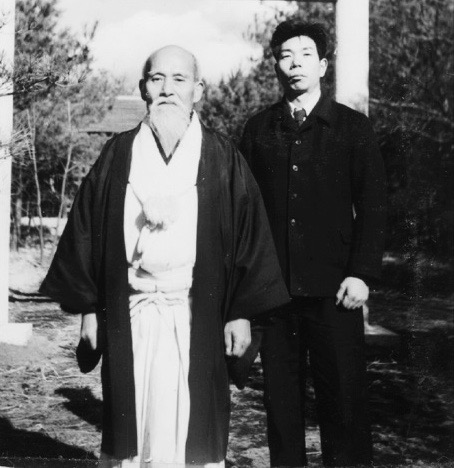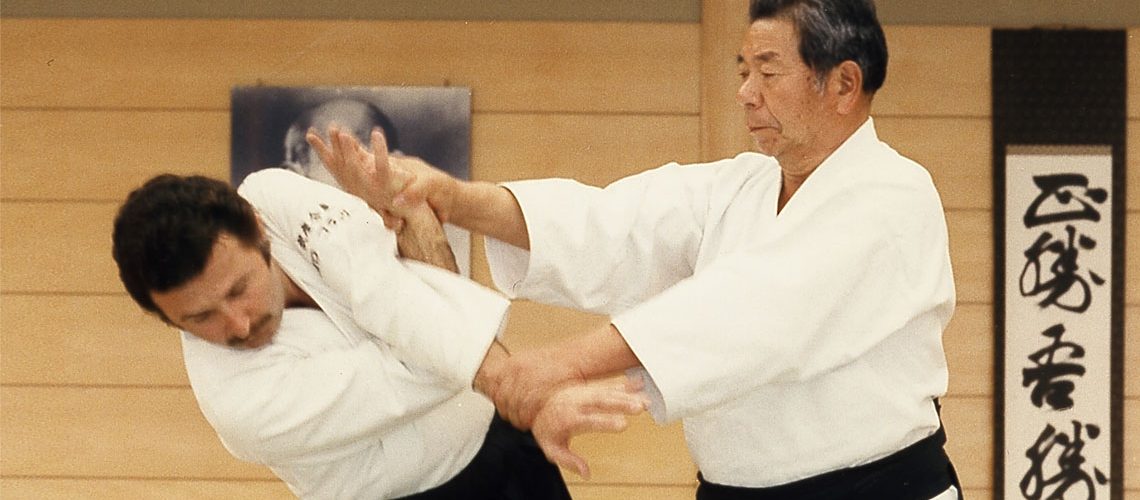The following is an excerpt from the newly released Aikido Pioneers: Postwar Era, which contains in person accounts and insights with many of the closest post-WWII students of the founder of aikido, including Morihiro Saito Sensei.
Morihiro Saito was born in 1928 in Ibaraki Prefecture. He began studying aikido in Iwama at the age of eighteen. He was able to train closely with Morihei Ueshiba in the postwar years thanks to his 24-hours-on, 24-hours-off schedule as a Japan National Railways employee. Saito Sensei became an Aikikai shihan in January 1959, and in 1969, after O-Sensei’s death, became the chief instructor at the Iwama dojo and guardian of the Aiki Shrine in Iwama. He published the well-known five-volume work Traditional Aikido and the books in the Takemusu Aiki series. In addition to his teaching in Japan, Saito Sensei traveled regularly to both the US and Europe to teach aikido, and built an international following that was strengthened by the foreign practitioners who were able to study as live-in students at Iwama. He passed away in 2002 at the age of seventy-four.
Saito Sensei, I understand you met O-Sensei shortly after the war. How was it that you decided to begin studying aikido? Would you please describe your memories of that period?

When I was a youngster, I used to admire the great swordsmen just like everyone else. I would buy story magazines and read about people like Goto Matabe and Yagyu Jubei, since when I was growing up before and during the war, if a boy didn’t know judo or kendo he was ashamed. Naturally, kendo and judo were taught as a part of school education, and I chose to practice kendo. Then came the end of the war. At that time, you couldn’t carry a weapon. No one was permitted to carry even so much as a small knife. So I began to go to the Shudokan Hall in Meguro, as I thought it would be dangerous if I didn’t know some kind of technique. In Meguro there was a teacher of Shinto-ryu karate. He was a professor at Nihon University. I would go there and train hard at karate. Because of my family situation I was working in Tokyo at that time.
Then I was transferred here so I couldn’t go to train in Tokyo anymore. Then I went to a dojo in Ishioka. It was a judo dojo. In those days I thought that if you knew both karate and judo . . . judo is good in a hand-to-hand fight and also karate is better than kendo because a karate man can use his feet . . . but kendo is better with a weapon . . . so I thought I would have nothing to fear if I knew kendo, karate, and judo. But there was this old man doing strange techniques up on the mountain near Iwama. Some people said he did karate, and a judo sensei told me it was called “Ueshiba-ryu judo.”
“…there was this old man doing strange techniques up on the mountain near Iwama… it was frightening up there and I was afraid to go.”
Anyhow, it was frightening up there and I was afraid to go. I had a very strange feeling and it was eerie, but still some of my friends and I agreed to go up there and have a look. But my friends got scared and didn’t show up. So I went alone. It was during the hot season, and I went in the morning. O-Sensei was over here doing morning training. His house was over there. Minoru Mochizuki, who went to Italy and France many years ago, was sitting over there. “Sensei’s over there,” he said to me, and when I jogged over here, Akio Kano, Tadashi Abe (who went to France in the early days) and one of the sons of the famous Ishihara Industry family—the three of them were training with O-Sensei. Then I went into what is today the six-tatami-mat room, and while I was sitting there, O-Sensei and Mr. Abe came in. When O-Sensei sat down, Mr. Abe put down a cushion for him immediately. He really moved fast in helping O-Sensei.

Then he stared at me. O-Sensei asked, “Why do you want to learn aikido?” When I answered I’d like to learn if he would teach me, he asked me, “Do you know what aikido is?” There was no way I could know about it. Then Sensei said, “I’ll teach you how to serve society and people with this martial art.”
I didn’t have the least idea that a martial art could serve society and people. I just wanted to become strong. Now I have come to understand, but at that time I didn’t understand at all. I think O-Sensei was already spiritually advanced at that time. I had been practicing martial arts just to become strong. When he said “for the benefit of society and people,” I doubted how a martial art could serve that purpose, but as I was eager to be accepted, I unwillingly answered, “Yes, I understand.” As I stood on the mat in the dojo rolling up my shirt sleeves, thinking to myself, “Well, since I’ve come all the way here, I might as well learn a couple of techniques.” O-Sensei said, “Come and strike me!” So I went to strike him and tumbled over. I don’t know whether or not it was kotegaeshi or what, but I was thrown. Then he said, “Come and kick me!” When I tried to kick him, I was gently overturned. “Come and grab me!” I tried to grab him judo-style, and again I was thrown without knowing how. My shirt sleeves and my pants ripped. Sensei said, “Come and train if you like.” With that, he left the mat.
“Then Sensei said, “I’ll teach you how to serve society and people with this martial art.” I didn’t have the least idea that a martial art could serve society and people. I just wanted to become strong. Now I have come to understand, but at that time I didn’t understand at all.”
I heaved a sigh of relief to think that I was accepted, since Sensei had told me to come and train if I wanted. But Mr. Abe said to me, “O-Sensei can judge people. From what he said it looks as though you’ve been accepted. But we have an organization named the Aikikai and we can’t accept you without their discussing the matter. Wait for three days. Recently a man came from Hokkaido and said, “I am going to practice aikido, do or die!” We told him to watch the class, but he went home the next day and said that he wanted to think it over. I felt hurt being told that kind of thing by Mr. Abe, so I said, “I will endure as long as my body lasts!” It didn’t mean anything. Mr. Abe was just testing me. When I became a student, I found Mr. Abe took good care of the junior students . . . he taught us in a kind, polite manner. I still appreciate it very much. In the same way that Mr. Abe was kindly taught like a brother by Mr. Tohei when he began, I was taught kindly in turn like a brother by Mr. Abe.
Anyway, here I found an entirely new atmosphere. O-Sensei was somehow awe-inspiring to me. Though his body was small . . . it is something I can’t express. His eyes twinkled and there was something gentle in his severity when he spoke. I made up my mind to learn at all costs. I began to train. It was painful and my body ached, and I thought it would have been better to be beaten up in a fight. But when evening came, I would go to the dojo again. Once, when I had put a plaster on, I was scolded by O-Sensei, “Idiot!” So at the dojo I removed the plaster and after the workout I would hurry to take a bath and put it on again. Whenever I would have a pained expression on my face, they would torture that part of the body even more. While this kind of thing happened again and again, I found myself absorbed in aikido.
The full dialogue with Saito Sensei in included in Aikido Pioneers: Postwar Era, along with accounts from Seiseki Abe, Katsuaki Asai, T.K. Chiba, Seishiro Endo, Masatake Fujita, Shizuo Imaizumi, Kayoichi Inoue, Hiroshi Isoyama, Mitsunari Kanai, Yasuo Kobayashi, Shoji Nishio, Mitsugi Saotome, Masando Sasaki, Kenji Shimizu, Seichi Sugano, Hiroshi Tada, Hideo Takahashi, Mariye Takahashi, Nobuyoshi Tamura, Moriteru Ueshiba, and Yoshimitsu Yamada.













Iam a student of akido under Sensei Goss in belair md
That was very interesting reading. Sensei Morihiro Saito eventually became a very skilled
Aikidoka. But I have some disbelive that he was thrown to the ground several times, the first time he arrived and met the Master. If he had done an attack with intention he couldn´t be thrown to the ground. He said he had skill in Kendo Karate and Judo
.I´m not trained in Aikido, but many of the Aikido techniques are rellay good, such as the deflection techniqes and many of the techniques for control of a person.
Anyway it was a good reading. / Leif (Swedish)
Leif, I heard a similar story from a US Marine trained in Judo while stationed in Japan back in the early 60s , he was standing there looking at O’Sensei , Sensei noticing his gaze walked up to him , said attack me with all your might, he did , the next thing was his flying through the air and hitting the mat with no memory of what may have happened……